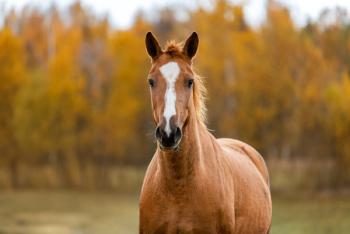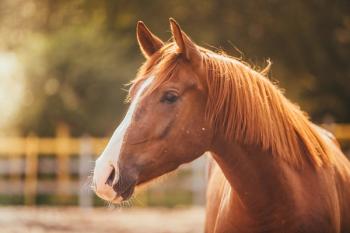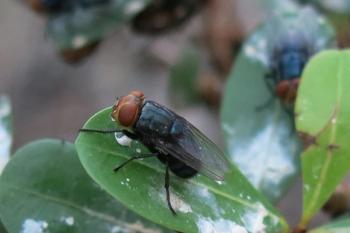
Hydrops rare, but know signs
Veterinarians can often go an entire career without seeing some types of cases.
Veterinarians can often go an entire career without seeing some types of cases.
This mare is 6 months pregnant and is showing the typical signs of a hydrops condition. Her abdominal distention is much more advanced than her gestational age.
They are described in textbooks and do occur, but mostly, we hope, in our colleges or in other practice areas.
Some such cases are very unusual, some are bizarre and some are just plain difficult to deal with. Hydrops of the fetal membranes of the horse is one such case. Hydrops is more commonly seen in cattle and, while it does occur in horses, many lucky practitioners can have busy careers without ever encountering this problem.
Constantly shifting process
As the fetus grows inside the mare's uterus a constantly shifting process is under way whereby fluids are produced and reabsorbed.
Some fluid is produced by the foal or fetal part of the placenta. This part is the amnion and the production of an abnormal amount of fluid results in a condition called hydrops amnion, hydramnion or hydramnios. If the problem is in the allantoic portion of the fetal membranes then the condition is called hydrops allantois or hydrallantois. This is the more common condition (occurring about 85 percent of the time) but both problems are considered rare.
Amniotic fluid can be identified by its high sodium content (>100 mmol/L) and allantoic fluid will be found upon penetrating the chorioallantois but the actual diagnosis and differentiation of the source of the fluid is largely an academic exercise. The main point is that these mares are producing huge volumes of fluid that they cannot reabsorb and the pregnancy is almost always fatally affected. The life of the mare may be in danger as well.
When does it occur?
Hydrops in the mare occurs most frequently between four to eight months of gestation.
These mares typically have a normal reproductive history, up to that point, and may or may not have produced normal foals in the past. There are no known predisposing factors of age or breed. Over the course of 10 to 14 days these mares will rapidly accumulate fluid to the point where they appear ready to foal at any minute though they really have months to go.
These animals may show abdominal discomfort or mild colic due to excessive pressure of the uterus on the rest of the intestines. They may have difficulty breathing because of pressure on the diaphragm.
This mare has suffered a ruptured prepubic tendon. Her mammary glands are pulled cranially and she has a characteristic upward tilt to her pelvis. Ventral edema is also evident.
Mares may walk with difficulty, some show severe ventral edema and some may even become recumbent. Rupture of the abdominal muscles or of the prepubic tendon can also occur.
Rupture of the prepubic tendon causes an elevation of the mare's pelvis. Because of the reduced pull of the abdominal muscles the ischial tuberosities are tipped dorsally in these cases. The mare's udder is also pulled cranially though mares with hydrops may not have yet developed a bag so that this anatomical shift may not be noticeable. The ventral edema that sometimes occurs with prepubic tendon rupture may also make this change difficult to observe.
Mares with prepubic tendon rupture can survive and partial reduction of the tear can occur to the point where these mares may appear normal. They are continually at risk of recurrence however. Some mares will retain a "dropped belly" appearance and may have long term complications related to locomotion, circulation and/or digestion.
Termination necessary
Terminating a hydrops pregnancy is necessary for two main reasons.
Reducing the weight of the uterus on the abdominal muscles is necessary to avoid a rupture of the prepubic tendon. Removing the excessive volume of fluid in a controlled way is also crucially important to prevent spontaneous abortion and hypovolemic shock, which can be fatal to the mare.
Even though the excessive fluid is found in the fetal tissues, that volume is part of the mare's circulatory system. Rapid loss of potentially 20 to 30 liters of fluid can drop blood pressure so severely that shock and death can occur. If spontaneous abortion and this massive fluid loss occur when the horse is unobserved, then it may not be possible to assist the mare. For this reason, abortion of these cases is the treatment of choice.
Abortion
Abortion is usually induced by gradual cervical dilation (over 15 to 20 minutes).
Prior to induction, it is advisable to place a jugular catheter and to begin intravenous fluid support. Fetuses associated with cases of hydrops have been delivered alive but usually they are too premature to survive and must be euthanized.
Some hydrops foals are normal but many have some type of abnormality including wry neck, growth retardation, limb ankylosis, hydrocephalus, hydrancephaly, scoliosis and other problems.
Once the cervix is dilated, the fetus is extracted and drainage of the large volume of fluid is begun. Placing a sterile gloved hand with a large diameter stomach tube into the uterus is the best method of drainage.
The volume of fluid passing through the tube is controlled and either increased or decreased depending on the heart rate of the mare and her condition. This process may take from an hour to two and the mare may be supported with oral electrolytes after the acute phase has been passed.
These mares are usually placed on systemic antibiotics because of the induced abortion and they typically show normal uterine involution once the fluid has been removed. These mares can become pregnant following a hydrops pregnancy though statistical data is lacking. Though the exact cause of hydrops is unknown it is postulated that vascular defects caused by uterine and umbilical torsion may start the process.
One case of hydrops allantois was caused by placentitis and a heritable cause has been suggested. Normal pregnancies have occurred to hydrops mares bred back to different stallions, so there may be some validity to the heritable cause theory. But, because there are simply too few hydrops cases, we may never truly understand the condition.
Even if, as practitioners, we are lucky enough to never encounter this rare problem, it is important to recognize such a mare and to be able to handle the case. There is always that chance that the next mare you are called to see will be that one-in-a-career horse.
Newsletter
From exam room tips to practice management insights, get trusted veterinary news delivered straight to your inbox—subscribe to dvm360.




